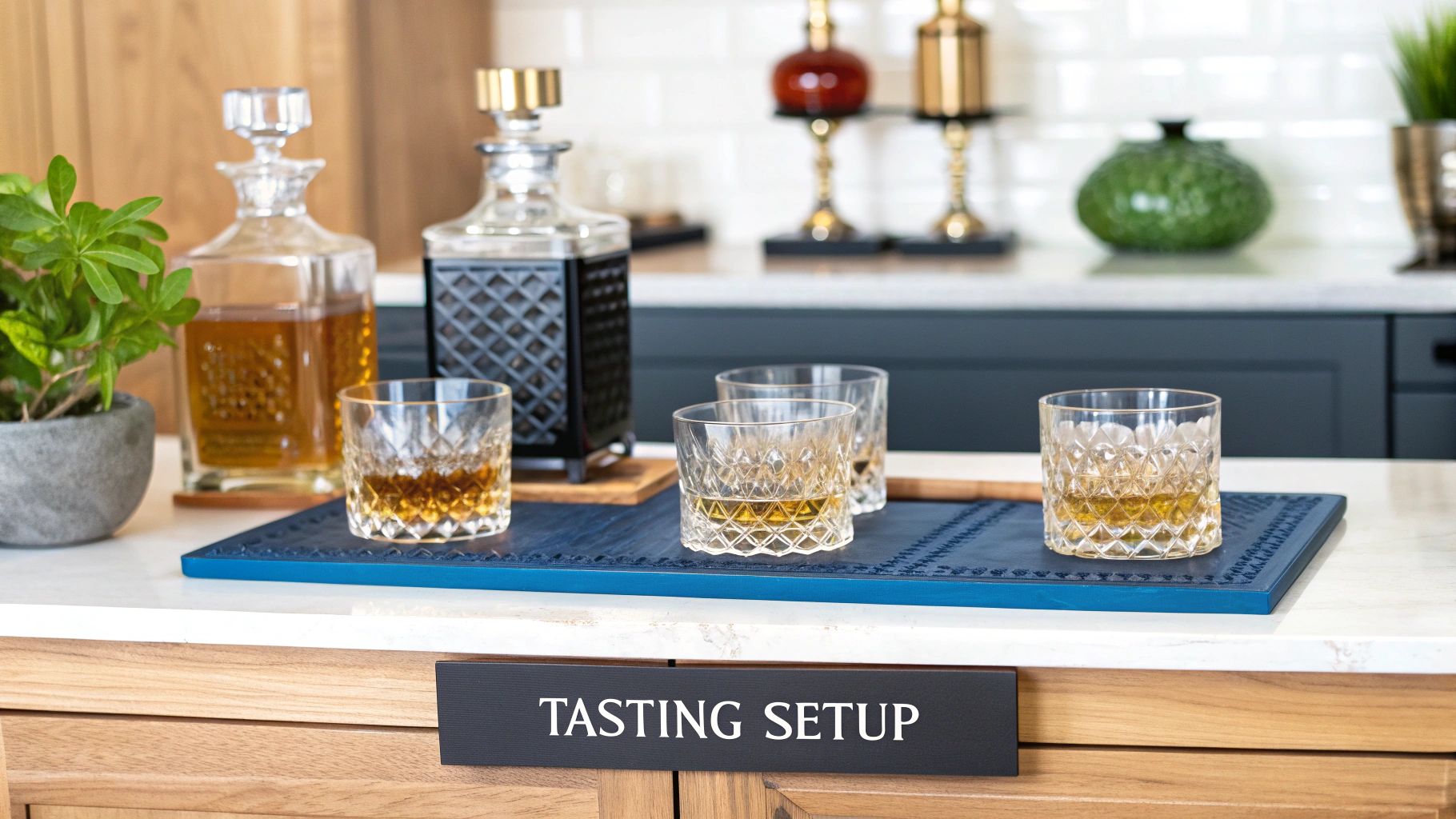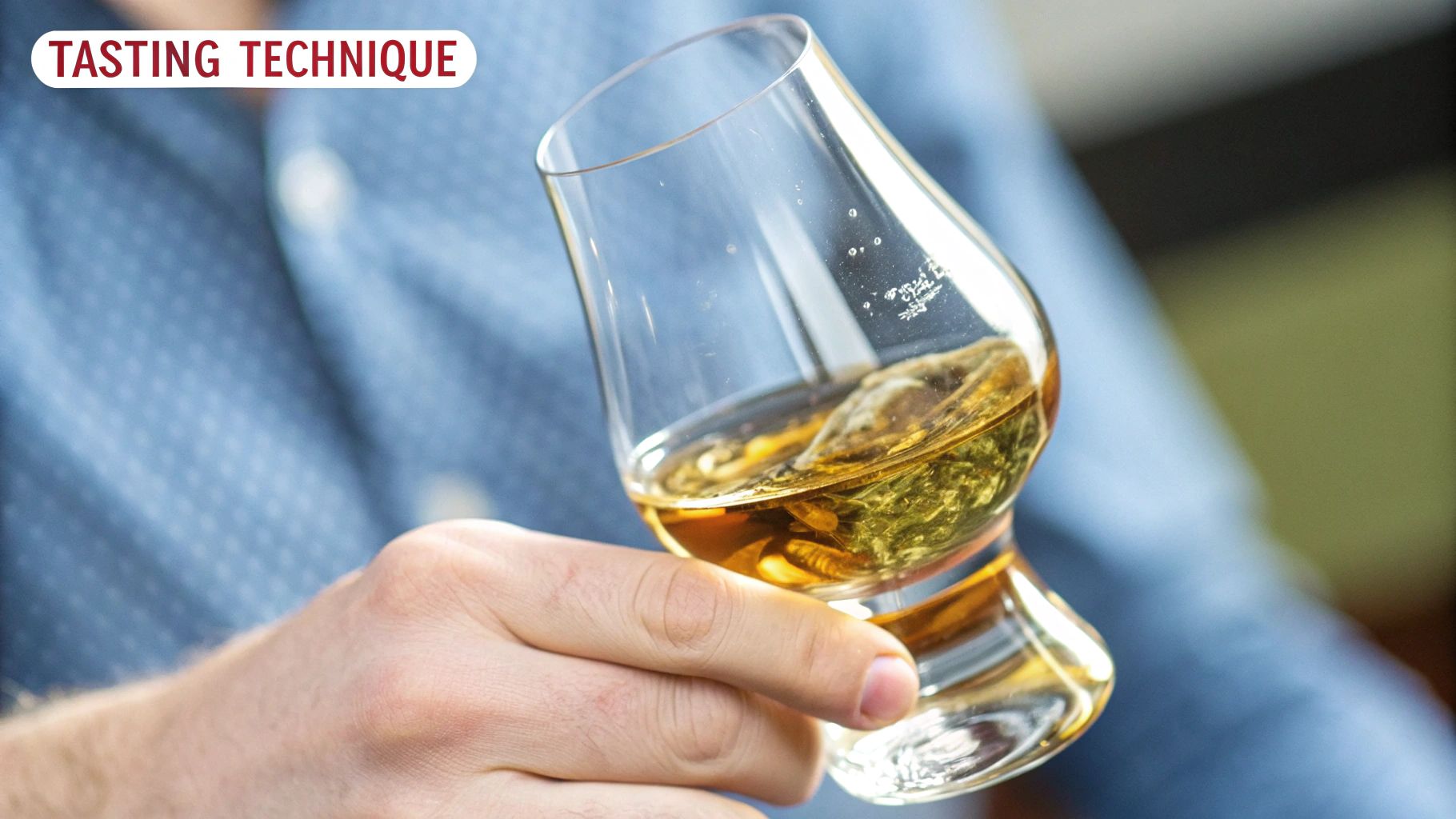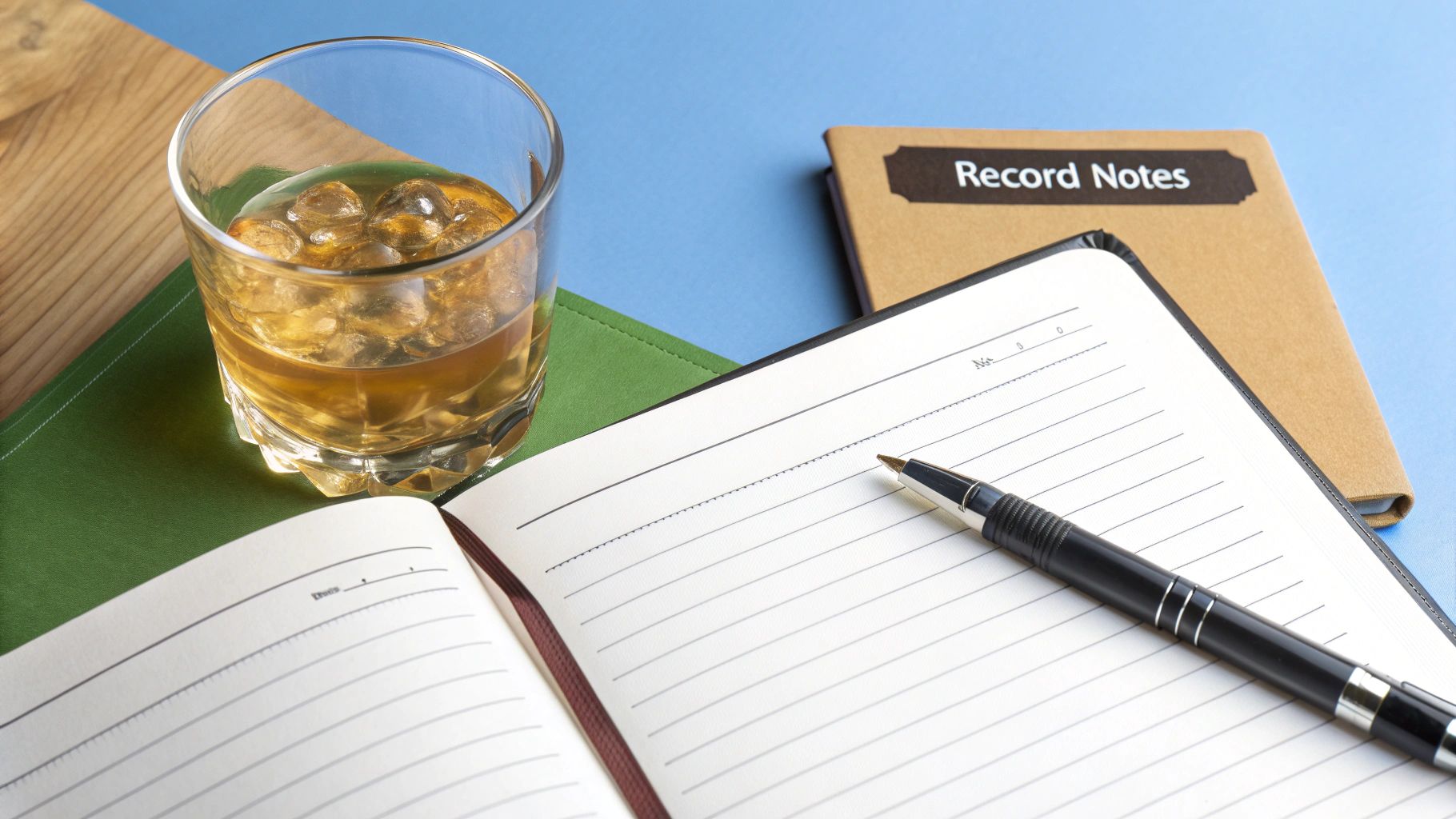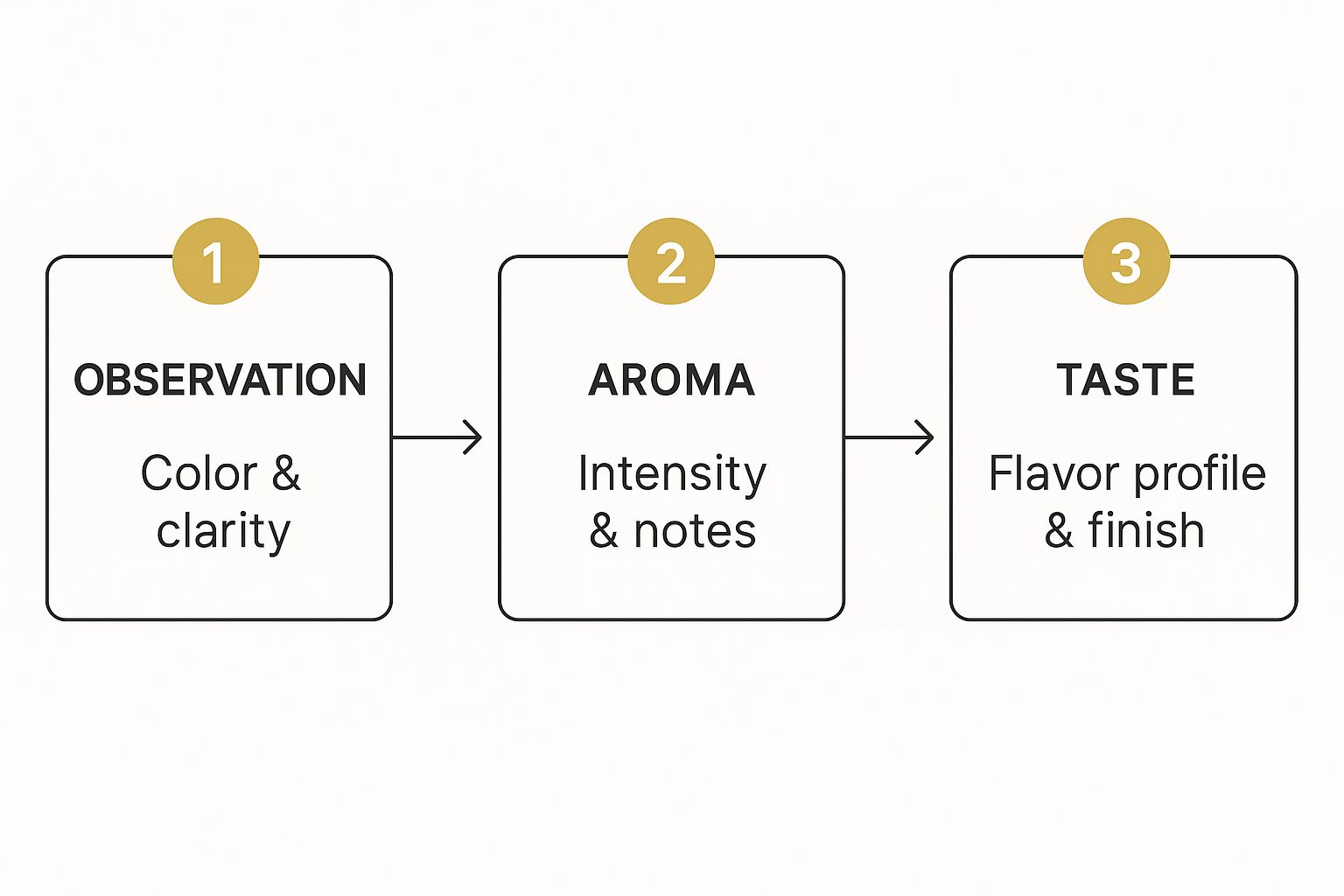There's nothing quite like exploring a few complex spirits from the comfort of your own living room. Hosting an at home whiskey tasting is a fantastic way to do just that in a relaxed, personal setting. It's an experience you can tailor completely to your own tastes and curiosity, and this guide will walk you through putting together a memorable event for everyone, from total beginners to seasoned sippers.
Why Host Your Own Whiskey Tasting at Home

Let's be honest, trying to appreciate the subtle notes in a fine spirit while shouting over the noise of a crowded bar is less than ideal. Hosting at home puts you in the driver's seat, letting you create a comfortable and pressure-free environment that’s all about discovery.
This isn't just a niche idea; it's part of a much bigger movement. The global whiskey market hit a value of USD 72.7 billion in 2024, and it's booming. Much of that growth comes from a surging interest in premium and craft spirits. As more people hunt for unique experiences, the appeal of a personalized tasting has absolutely skyrocketed. You can read more about the growth of the whiskey market on gminsights.com if you're curious.
A Personalized and Educational Experience
The real magic of hosting is the freedom to curate the entire event. You get to set the theme, hand-pick the guest list, and control the pace. This is a game-changer, especially for folks who are new to whiskey and might feel a bit intimidated in a more formal setting.
An at-home tasting gives you the chance to:
- Explore Niche Categories: You can build a flight that focuses exclusively on American craft rye from tiny distilleries or maybe compare a few bourbons with wildly different mash bills. The possibilities are endless.
- Learn at Your Own Pace: There’s no bartender rushing you along. You and your friends can take all the time you need to discuss aromas, flavors, and finishes.
- Create a Social Connection: A tasting is so much more than just drinking—it’s a shared activity. It’s a natural conversation starter and a great way to make some lasting memories with friends.
The real beauty of an at-home tasting is its accessibility. It strips away the pretension that can sometimes surround whiskey and turns it into a fun, collaborative exploration of flavor, story, and craft.
Ultimately, it’s about making the world of whiskey your own. When you bring that distillery experience into your home, you create a space where everyone can learn, share, and maybe even discover their next favorite pour.
How to Select Whiskeys for the Perfect Flight

This is where the fun really begins. Choosing the right bottles is what separates a simple get-together from a truly memorable at home whiskey tasting. A great selection tells a story and guides your guests on a journey. So instead of just grabbing random bottles off the shelf, it’s time to think like a curator and build a flight around a central idea.
For most tastings, I’ve found that a lineup of three to five different whiskeys is the sweet spot. This range offers plenty of variety for comparison without completely overwhelming everyone's palate—a crucial point if you have guests who are newer to the world of whiskey.
Build a Tasting Around a Theme
A theme is your secret weapon. It gives the tasting focus, turning it from a simple sampling into a genuine exploration. Honestly, it’s the best way to make the experience more educational and fun for everyone involved.
Here are a few of my go-to flight ideas to get you started:
- A Tour of American Craft: This is a fantastic way to showcase the incredible diversity happening in our own backyard. You could feature a wheated bourbon from Wyoming Whiskey, a bold single malt from a Texas distillery like Balcones, and a classic rye whiskey from Pennsylvania's Stoll & Wolfe to show just how different American whiskey can be.
- Bourbon 101: Absolutely perfect for beginners. This theme lets you explore how different grain recipes change the final product. Line up a traditional corn-heavy bourbon, a much softer "wheater," and a high-rye bourbon for that signature spicy kick.
- Vertical Tasting: This one is for when you find a distillery you absolutely love. Pick several of their expressions to see how they play with their own spirit. For example, you could taste a distillery's flagship bourbon, a unique single barrel pick, and a cask strength version to really highlight how proof and barrel selection create wildly different profiles.
And if you're looking to venture beyond American shores, you can find a solid list of single malt whiskey recommendations to inspire a whole new theme.
Sourcing Your Bottles and Reading Labels
Once you've landed on a theme, the hunt is on. I always encourage people to support smaller, independent distilleries. It's the best way to discover truly unique spirits you won't find on every bar shelf. When you're shopping, pay attention to the labels—details like the mash bill, age statement, and barrel type are your clues for building a great flight.
Thanks to a booming global trade, we have an incredible variety at our fingertips. In 2024-25, an estimated 1.4 billion bottles of whiskey were exported worldwide, with the U.S., the U.K., and Japan leading the way. That means you have direct access to a huge range of styles right at your local shop. You can dive deeper into these global whisky export trends at TradeImex.in.
Tip for New Drinkers: Feeling overwhelmed at the store? Don't hesitate to ask for help! Tell the staff you're hosting an at-home tasting and what your theme is. They often have fantastic recommendations for American craft whiskeys that you might otherwise overlook.
Sample American Craft Whiskey Tasting Flights
To give you a head start, here are a few specific flight ideas that I've found work incredibly well for showcasing the diversity of American craft whiskey.
| Theme | Whiskey 1 (Example Brand) | Whiskey 2 (Example Brand) | Whiskey 3 (Example Brand) | Tasting Focus |
|---|---|---|---|---|
| The Mash Bill Breakdown | Wyoming Whiskey Small Batch (Wheated Bourbon) | New Riff Single Barrel (High-Rye Bourbon) | Pinhook Rye (Rye Whiskey) | Comparing how wheat vs. rye grain impacts sweetness and spice. |
| An East vs. West Showdown | Westland American Single Malt (Washington) | Balcones Texas "1" Single Malt (Texas) | Westward Whiskey Cask Strength (Oregon) | Exploring the influence of regional climate on the aging process. |
| Finishing School | High West A Midwinter Night's Dram (Port Finish) | Angel's Envy (Port Finish) | Hillrock Solera Aged Bourbon (Sherry/Oloroso Finish) | Highlighting how finishing barrels add layers of complexity and flavor. |
These are just jumping-off points, of course. The best part is tailoring the experience to what you and your guests are most excited to try. By thoughtfully selecting your whiskeys, you’re not just pouring drinks—you’re setting the stage for a rich and rewarding experience.
Setting the Stage for a Great Tasting

The whiskeys you pick are the main event, but the environment you create around them is just as crucial. A little thoughtful prep can transform a simple tasting into a truly memorable experience. This isn't about being pretentious; it's about setting up the whiskey—and your guests—for success.
Your choice of glassware is probably the single most important decision you'll make. A standard rocks glass is great for a casual drink, but its wide opening lets all those delicate aromas vanish into thin air. For a proper tasting, you need a glass that captures and concentrates those scents.
Essential Tools for Your Tasting
There's a reason the Glencairn glass is the industry standard. Its unique tulip shape, featuring a wide bowl that tapers to a narrow rim, is engineered to focus the whiskey's bouquet. This makes it so much easier to pick up on the subtle notes hiding in the glass. Honestly, investing in a good set is a game-changer for any at home whiskey tasting. If you need the right gear, a dedicated whiskey tasting glass is exactly what you're looking for.
Beyond the perfect glass, a few other items will make the whole experience run smoother.
- Water Droppers: A small pipette or dropper is perfect for adding a single drop of water. This little trick can "open up" higher-proof whiskeys, unlocking new layers of flavor and aroma you might have missed.
- Palate Cleansers: Keep it simple. Unsalted crackers or plain bread are your best friends here. Their job is to reset your palate between whiskeys without introducing any competing flavors.
- Tasting Mats: You can find these online or make your own. A simple printed mat with spots for each glass not only keeps things organized but also gives everyone a dedicated place to jot down their thoughts.
Creating the Right Atmosphere
The vibe of your tasting space has a massive impact. You want to dial down any sensory distractions so the focus stays squarely on the whiskey. Check out these expert tips for creating a cozy and inviting atmosphere to get your guests feeling relaxed and ready to dive in. That means no scented candles, no air fresheners, and definitely don't cook bacon right before everyone arrives.
Good, neutral lighting is another key piece of the puzzle. It lets everyone get a proper look at the color and viscosity—the "legs"—of each whiskey. It's the small details that create the ideal setting for discovery.
Tip for New Drinkers: Remember to keep the pours small. A tasting-sized sample of 0.5 to 0.75 ounces is all you need. This encourages thoughtful sipping instead of gulping and, just as importantly, prevents your palate from getting overwhelmed. You want the last whiskey to taste just as good as the first.
This mindful approach also taps into a bigger trend. More and more people are embracing moderation, choosing high-quality experiences over sheer quantity. It's about savoring premium craft spirits in smaller amounts, which allows you to splurge on a few really unique bottles for your event. By setting the stage correctly, you’re not just pouring drinks—you’re curating an experience.
How to Actually Taste Whiskey Like a Pro
Alright, the stage is set. Your glasses are clean, the whiskey is poured, and your friends are ready. Now for the main event: actually tasting the whiskey. This is where we go from simply drinking to truly experiencing the spirit, uncovering the complex story each pour has to tell.
It's a simpler process than you might think, breaking down into three key actions: looking, smelling, and finally, tasting. Don't rush it. The first few moments you spend with the whiskey in your glass are packed with clues about its character, long before it ever touches your lips.
The Art of Observation
First things first, just look at it. Hold your glass up to a light source. What color do you see? Is it a pale straw, a rich, glowing amber, or a deep, brooding mahogany? While not a foolproof indicator, a whiskey's color often gives you a hint about its age and the kind of cask it matured in.
For a much deeper dive into what these visual cues mean, check out our complete guide on how to taste whiskey.
Next, give the glass a gentle swirl. Watch how the liquid runs back down the sides of the glass. Those streaks are what we call "legs" or "tears." Thicker, slower-moving legs can suggest a higher alcohol content or a more viscous, oily texture. This quick visual check helps set your expectations for what you're about to smell and taste.

As you can see, each step naturally flows into the next, building a complete picture of the spirit in your glass.
Nosing for Nuance
Your sense of smell accounts for the vast majority of what you perceive as flavor. This makes nosing the whiskey arguably the most critical part of an at home whiskey tasting. But there’s a technique to it.
Don't just stick your nose right in the glass—you'll get an overwhelming blast of alcohol that numbs your senses. Instead, hold the glass a few inches from your face. Keep your mouth slightly open as you gently inhale. This little trick allows you to pick up more subtle aromas without that harsh ethanol burn.
So, what do you smell? Is it sweet like vanilla or caramel? Fruity, like crisp apples or bright citrus? Or are you picking up spicier notes of cinnamon and oak?
Tip for New Drinkers: Don't be afraid to add a single drop of water, especially to a high-proof whiskey. This can tame the alcohol and dramatically open up the aroma, allowing hidden floral or fruity notes to emerge. It’s like unlocking a whole new room of scents.
If you’re just starting, identifying specific notes can be a challenge. That’s perfectly fine. Begin with broad categories. Does it smell generally sweet, smoky, fruity, or spicy? Once you have a category, you can start narrowing it down. For instance, "sweet" might evolve into pinpointing honey, rich caramel, or dark brown sugar. It’s a skill that sharpens with every glass.
To help you and your guests get started, here's a quick cheat sheet with common notes to look for.
Whiskey Tasting Notes Cheat Sheet
| Category | Common Notes to Look For |
|---|---|
| Sweet | Vanilla, Caramel, Honey, Brown Sugar, Toffee, Maple Syrup, Chocolate |
| Fruity | Apple, Pear, Cherry, Orange, Lemon, Peach, Plum, Raisin, Fig |
| Spicy | Cinnamon, Nutmeg, Clove, Black Pepper, Ginger, Anise |
| Woody/Earthy | Oak, Cedar, Tobacco, Leather, Charred Wood, Earth, Grass, Hay |
| Grainy | Malt, Barley, Corn, Rye Bread, Cereal, Toasted Grains |
| Smoky | Peat Smoke, Campfire, Iodine, Brine, Medicinal |
| Floral | Heather, Honeysuckle, Rose, Lavender |
| Nutty | Almond, Walnut, Hazelnut, Peanut |
This table is just a starting point. The more you taste, the more your personal vocabulary for describing whiskey will grow.
The Sip and the Finish
At last, it's time for a taste.
Take a small sip, just enough to coat your entire tongue. Before swallowing, gently move the whiskey around in your mouth for a few seconds. Some people call this the "Kentucky Chew." It ensures the spirit hits all your different taste receptors.
Now, focus. What flavors are you experiencing? Do they line up with what you smelled? You might notice sweetness on the tip of your tongue, then drier, oakier notes toward the back. Pay attention to the mouthfeel, too. Is it thin and light, or does it feel rich, oily, and creamy?
The final piece of the puzzle is the finish—that lingering taste and sensation after you swallow. Does it disappear quickly, or does it hang around with a long, warm, spicy glow? A long and complex finish is often the signature of a truly well-crafted whiskey. Taking the time to appreciate these three distinct phases—the initial taste, the mouthfeel, and the finish—will fundamentally change how you experience every single pour.
Make Your Tasting Interactive and Fun
A great at home whiskey tasting is so much more than just a quiet analysis of what’s in the glass. The real magic happens when you turn that analysis into a lively, shared experience. You want to get people talking, laughing, and connecting over the whiskeys you've put in front of them.
To get the ball rolling, hand out a simple tasting note template to each guest. This doesn't need to be some intimidating, technical document; a few prompts for aroma, taste, and finish are all you need. Just encouraging people to jot down their first impressions gives even the newest drinkers a framework to work with, turning a potential "I don't know what to say" moment into a fun little challenge.
Spark Conversation with Fun Activities
Low-pressure games are one of my favorite ways to break the ice and get everyone involved. They shift the focus from being "right" to simply sharing what you think, which is a huge relief for anyone who might feel intimidated by the whole thing.
A semi-blind tasting is a classic for a reason. It's simple: just hide the identities of the bottles until the very end. This trick instantly removes all preconceived notions and brand bias, letting everyone's palate do the real work. You'll be amazed at the surprising favorites that emerge.
Revealing the whiskeys at the end is the best part. It’s that "aha!" moment where someone discovers their new favorite pour came from a small, unheard-of American craft distillery, not a big-name brand. It completely changes how people view their own preferences.
Creative Games for Any Group
Another fantastic activity is a "flavor association" game. You just ask your guests to pair each whiskey with something totally subjective, like a memory, a song, or even a type of food. It encourages creative, personal descriptions instead of dry, technical tasting notes, making the whole experience feel more relatable for everyone.
For instance, a smoky, peated whiskey might remind someone of a campfire on a crisp fall night. A sweet, wheated bourbon from an American craft brand like Wyoming Whiskey, on the other hand, might bring back memories of baking caramel-drizzled desserts. It’s a simple way to make the abstract world of flavor incredibly personal.
To really kick things up a notch, you can weave in some other interactive elements, much like you would with unforgettable dinner party games. The key is to keep the activities light, inclusive, and centered on that feeling of shared discovery. These little touches ensure your event is remembered not just for the great whiskey, but for the great conversations and connections it sparked.
Answering Your At-Home Whiskey Tasting Questions
Even with the best game plan, a few questions always crop up when you’re putting together your first at-home whiskey tasting. Let's run through some of the most common ones I hear, so you can host an awesome event for everyone from total newcomers to seasoned pros.
How Many Whiskeys Should I Serve for Beginners?
When your guests are new to tasting, less is absolutely more. Stick to a flight of three or four different whiskeys. This is the perfect number—it gives you enough variety to draw comparisons without completely overwhelming everyone's palate.
It's easy to get sensory overload when you're just starting out. A smaller flight lets everyone take their time, really dig into each pour, and discuss what they're experiencing without feeling rushed. A great place to start might be a classic bourbon, a spicy rye from an American craft distillery, and a lighter American single malt to really showcase the different flavor profiles out there.
What Food Pairs Well with a Whiskey Tasting?
The golden rule here is to keep it simple. The food is there to cleanse the palate between samples, not to steal the show from the whiskey.
Think of your snacks as a way to hit the reset button. A few killer options include:
- Plain water crackers or a simple, unseasoned bread.
- Unsalted nuts like almonds or walnuts are perfect.
- Dark chocolate with a high cocoa percentage (70% or more) can be a fantastic pairing.
- Mild, hard cheeses, like a straightforward cheddar or gouda, work well.
Steer clear of anything super spicy, greasy, or with a ton of flavor. Strong tastes will hang around and make it tough to pick up on the subtle notes in the next whiskey. A pro move is to save the more substantial snacks for after the "official" tasting part of the evening is over.
Tip for New Drinkers: Go through the whole flight with just water and plain crackers first. Then bring out the cheese and chocolate to see how they play with your favorite pour of the night. This helps you learn the whiskey's true character without interference.
Do I Really Need Special Tasting Glasses?
Look, any glass will hold whiskey, but using a proper tasting glass like a Glencairn genuinely makes a huge difference. This isn't about being stuffy or pretentious—it's just physics. The unique tulip shape, with its wide bowl and tight rim, is designed to capture and concentrate all those amazing aromas.
This design funnels the bouquet right to your nose, making it way easier to pick out those subtle hints of fruit, spice, and oak that you might totally miss in a standard rocks glass. It’s a small change that delivers a big payoff in appreciating the spirit.
How Much Whiskey Should I Pour for Each Sample?
You'll be surprised how little you need. A standard tasting pour is just 0.5 to 0.75 ounces (that’s about 15-22 ml). Remember, this is a tasting, not a party—at least not yet! This tiny amount is more than enough to check the color, give it a good swirl, nose the aromas, and get a full taste.
Pouring smaller samples also keeps things responsible and ensures your guests' palates don't get shot by the end. It keeps the focus on careful assessment, so the last whiskey of the night gets just as fair a shake as the first. It just makes for a better, more insightful event for everyone.
Ready to take the guesswork out of your next tasting? Blind Barrels delivers a curated, mystery tasting experience right to your door. Discover top-shelf American craft whiskeys and let your palate lead the way.
